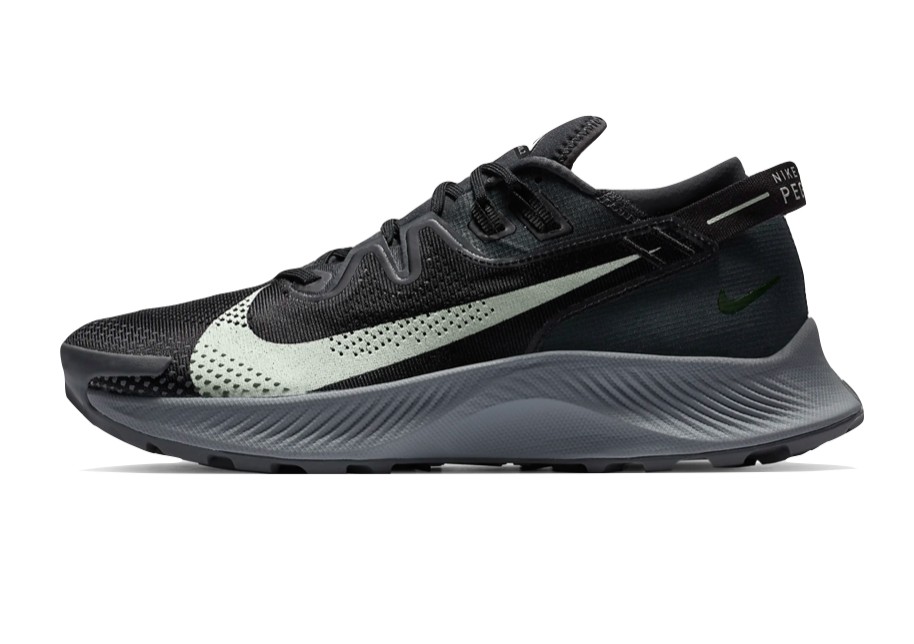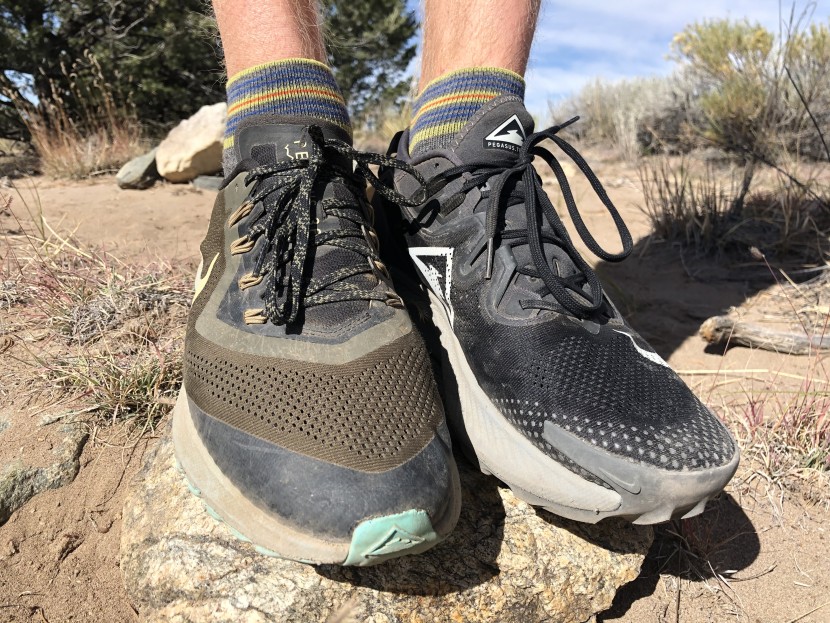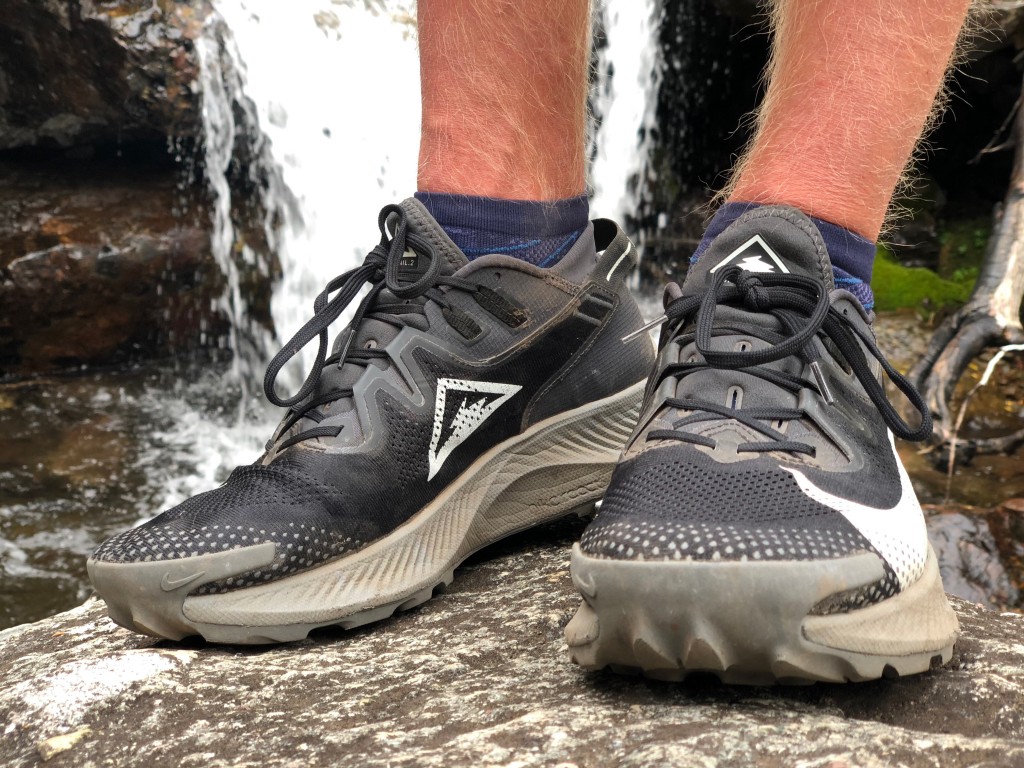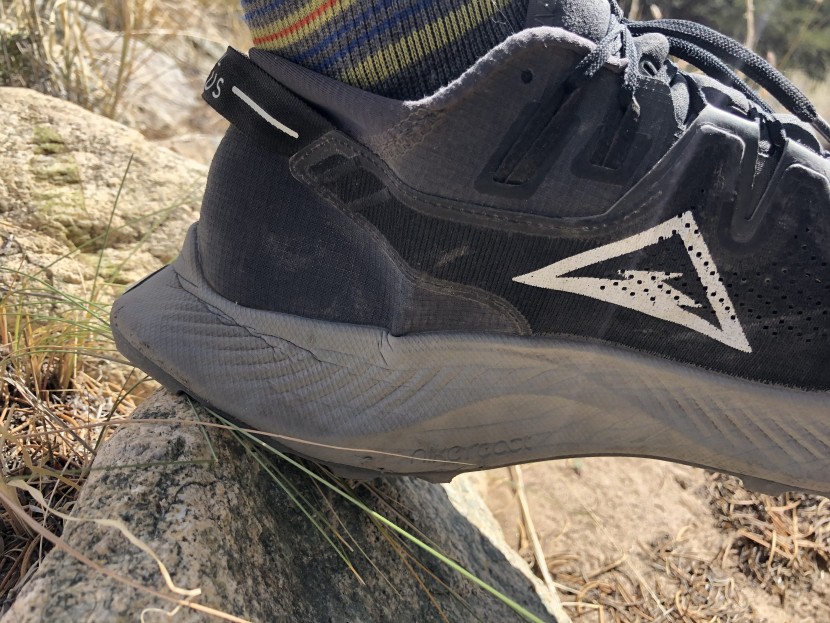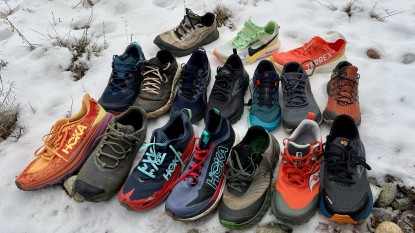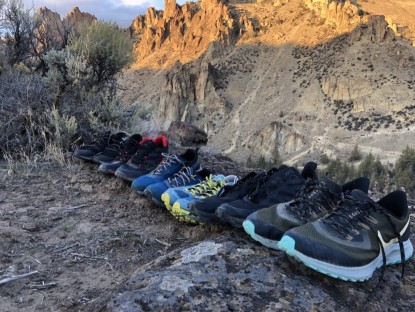Nike Pegasus Trail 2 Review
Our Verdict
Our Analysis and Test Results
Lovers of the Pegasus Trail 36 should not expect anything to be the same as the Pegasus Trail 2, as these shoes look different, feel different, and even have different materials and construction. This new version is Nike's most heavily cushioned trail shoe, with a thick React foam midsole that, in our opinion, is overly squishy and springy. This midsole has no Nike Air pockets embedded within, so it doesn't feel as rigidly supportive or as protective as one might have become used to if you wear a lot of Nike shoes. The foam itself is also not as firm feeling or as protective as the same React foam in the Wildhorse 6. The upper is fairly heavy duty, with a neoprene-like tongue and what they call a “faux gaiter,” which is essentially a high collar around the heel and ankle to help keep out debris. The traction is more aggressive than one might expect from Nike shoes, which is interesting since this is a cross-over shoe. To us the shoe feels overbuilt, lacking the low weight and superior protection of most Hokas, while also feeling heavy and unstable compared to the best Nikes.
Foot Protection
For a shoe that has so much foam in the midsole, we are disappointed with the amount of underfoot protection. The React foam is very squishy, such that there is great shock absorption, which is fine for urban trails or bike paths. But on a trail, where we often step on rocks and sticks, a surprising amount gets through to the foot. This isn't a bad thing necessarily, but many options with similar amounts of protection can be found that are lower to the ground, more stable, and lighter. It's only disappointing because it is such a large and bulky shoe.
The upper is similarly under-protected, made mostly of mesh but with very few overlays in areas of high wear. While we do greatly appreciate the short collar around the ankle and find that it works reasonably well, we also notice that the toe bumper, a glued-on piece of rubber, doesn't provide great coverage, and we incurred a blood blister in our big toe when accidentally kicking a rock racing downhill.
Traction
The outsole is one area of this shoe that has improved since the last version, with 4mm deep lugs spread out at substantial distances for shedding mud. The lugs have nice sharp cut edges for biting into loose terrain, and also fairly broad flat surface areas for increased friction and grip on hard packed surfaces. Like most Nike shoes, the rubber itself is on the harder side and doesn't stick very well to rock, especially wet rock. While not the most aggressive overall, the outsole works well to grip across most surfaces, and is one of the better attributes this shoe has to offer.
Stability
The stability of this shoe is our number one gripe, and ankles were rolled twice that we can remember during testing, with many other near misses. Many factors play into the instability, with the high 10mm heel-toe drop ensuring that the foot does not land on a flat platform while also keeping the heel raised high in the air. The thick foam stack also elevates the foot off the ground significantly. The worst culprit, however, is simply the lack of support from the foam itself — we found it to be so squishy that it can collapse either inward or outward, inducing the dreaded ankle roll at worst, or by simply throwing you off balance in an unpredictable way. Nike seems to have even recognized this propensity, as evidenced by the midsole splaying outward many millimeters all around the heel. We wish this feature was enough to compensate, but at one half marathon trail race that we wore these for, we felt we had to be extra deliberate not to hurt ourselves bombing downhill when we instead wanted to be confident enough to go all out.
Comfort
Like the vast majority of Nike shoes we have worn, these are indeed comfortable, which is noticeable the first time you put them on. The upper is sewn well with no seams or creases to rub the foot, and the shoe fits well. However, it is nowhere near as comfortable as the previous version, which we considered to be perhaps the comfiest trail shoe we'd ever worn. The fabric feels hot and heavy like there is simply too much of it. The tongue, despite having extra padding sandwiched into its neoprene like fabric, doesn't completely succeed in eliminating the feeling of the laces looping over the top of the foot.
In terms of fit, we feel it fits true to size and is of average width. While the forefoot may be slightly on the narrow side, the flexible mesh fabric allows the foot to expand a bit if needed, and the shoe doesn't feel tight or narrow like many others.
Weight
Our pair of men's size 11 shoes weighs in at 24 ounces even, which ranks it up there with the heaviest shoes in this review. Compared to the previous version, which we had at 21.3 ounces, it has gained nearly three ounces overall, which should put to rest any idea that this shoe will feel even remotely the same.
It's hard to consider running on roads or bike paths in a heavy shoe, and is only acceptable for trails if the increase in weight has a corresponding increase in foot protection to justify it. Unfortunately, the heaviness of this shoe negatively impacts the performance for both types of terrain in a way that simply doesn't make sense to us.
Sensitivity
Many maximally cushioned shoes have so much dense foam underfoot that there is almost total dissociation from the trail itself. This is not the case with the Pegasus Trail 2, as the foam cushions the repetitive impact of running, but does not seem to cushion exceptionally well the blows from rocks or roots underfoot. While some sensitivity is appreciated, it can also be accomplished in a lighter and more nimble shoe than this one.
Value
The price of this shoe is the same as all the other Nike trail shoes — basically average for a trail runner these days. While there is nothing wrong with the price tag in our minds, we found the shoe to be low performing and caught in a no-man's-land of not performing especially well for any given purpose. We have a hard time, then, suggesting that it would be a good value purchase.
Conclusion
The Nike Pegasus Trail 2 is the classic example of a poor re-do of what was already a pretty solid shoe. With a massive increase in weight and a corresponding loss of stability, performance, and comfort, we have a very hard time understanding what the goal of the shoe is. Nike's other two trail running shoes fit right up there with the cream of the crop, and we suggest you look in that direction long before you consider spending your money on this shoe.


